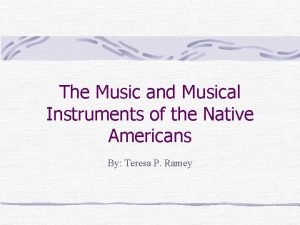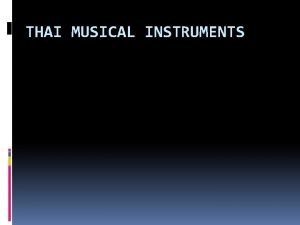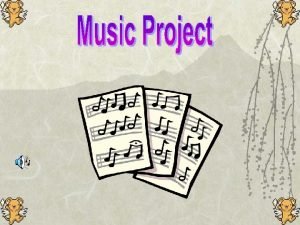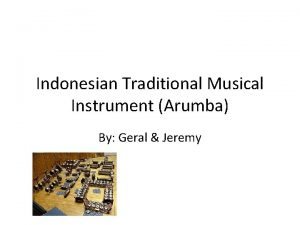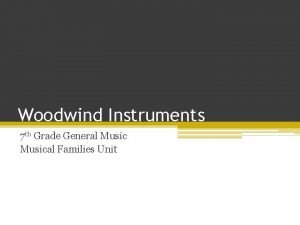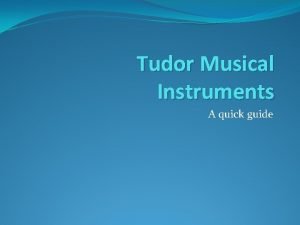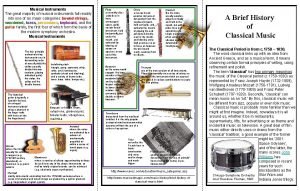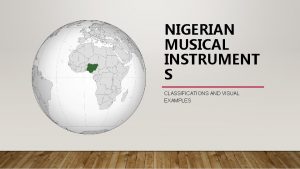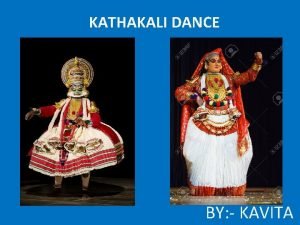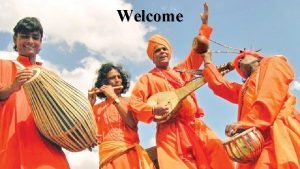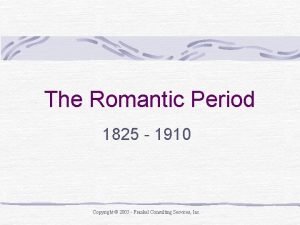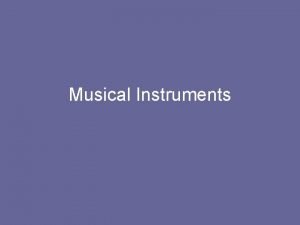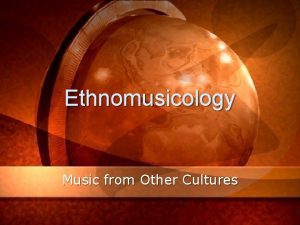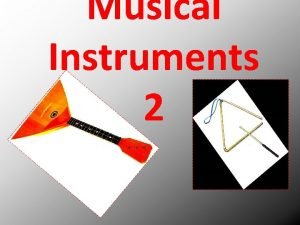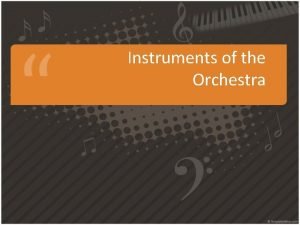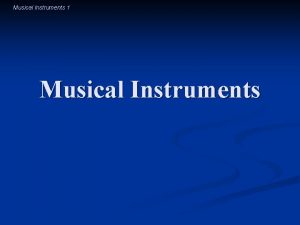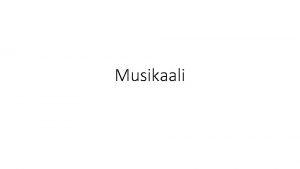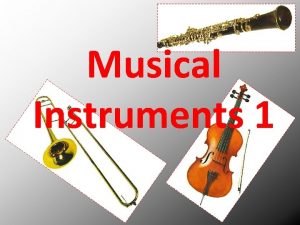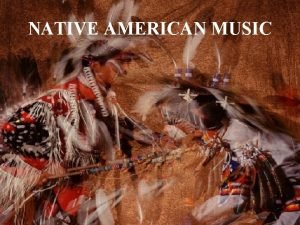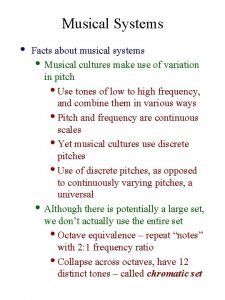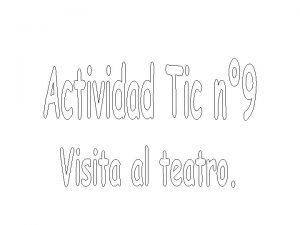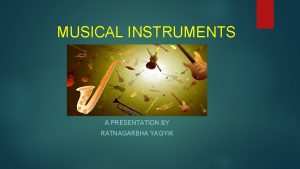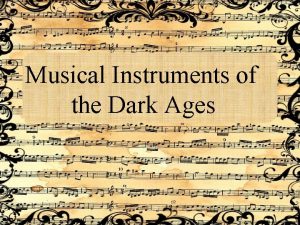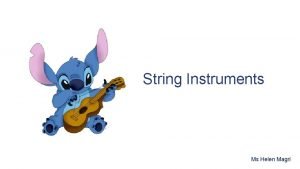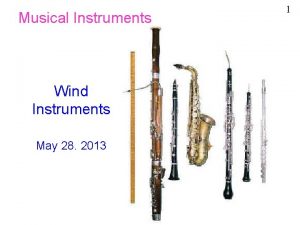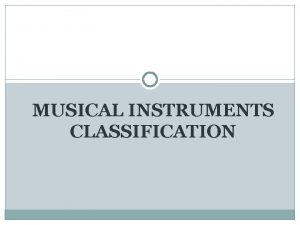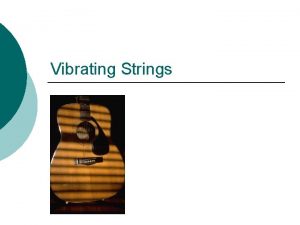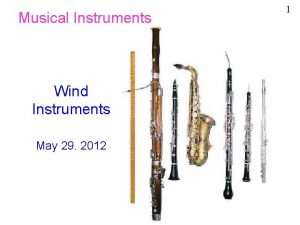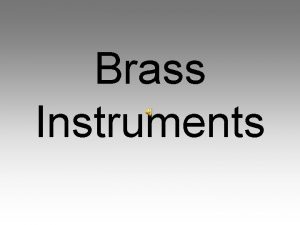The Music and Musical Instruments of the Native
























- Slides: 24

The Music and Musical Instruments of the Native Americans By: Teresa P. Ramey

Purposes of Native American Music Ceremonial Social Recreational

Ceremonial Music Ward off Evil Spirits Healing Hunting Harvesting Marriages Births Deaths Coming of Age

Social Music Dancing/sitting around the fire, telling stories of brave deeds, great warriors, great war/ battles Songs sung during work (grinding corn, tanning hides, weaving, etc. ) Lullabies

Recreational Music Songs sung during children’s play (game songs) Music performed, songs sung during tribal celebrations known as Pow-Wows

Native American Instrument Facts Most instruments of Native American tribes were percussion instruments. A few string and wind instruments were used also. Instruments were made of local natural resources. (e. g. skins, bones, seeds, shells, trees, etc. )

Ceremonial Drums These drums are mainly used during large tribal gatherings or celebrations. The small drums are played by an individual, while the large drums are played by a group of musicians. The frame of these drums are usually made of wood while the drum heads are made of animal hide.

Jawbone Rattle The jawbone rattle is made from the jawbone of a large dead animal (deer, elk, moose, buffalo). Once the marrow has dried up, pebbles are poured into the empty cavity and the hole is sealed with wax or clay. It is shaken in beat with the music to ward off evil spirits.

Medicine Rattles were made of shells or seed pods with sticks or cane. Medicine men (Shaman) used them to drive evil spirits from a person that was ill. Once the evil spirit had departed, the person would recover.

Mini Pow-Wow These drums were used in celebrations called pow-wows. It is constructed by hollowing out a log from a tree and stretching a skin over each end of the drum. The rawhide strips help hold the skin drum head taut.

Mouth bow This is a stringed instrument used by the Navajo Nation. The player places the end of the bow against their mouth and either plucks or bows the strings to make a sound. The mouth serves as a resonator in which the sound is made louder and the pitch of the instrument is changed according to the size of the players mouth.

Navajo Rattles These are rattles used by the Navajo Nation. They have been decorated with Native American Symbols, feathers, rawhide strips, animal fur and yarn.

Tortoise Shell Rattles These rattles are made from tortoise shells and sticks. The shells are filled with pellets, pebbles or seeds. The holes for the head, legs and tail are plugged up using wax or clay.

Water Drum This drum is a hollowed out log, half filled with water. A skin is stretched across one end and serves as the drum head. The beater is used to strike the drum. The vibrations of the drum head and the water give this instrument its unique sound.

Apache Spirit Flute The Apache spirit flute was used to communicate with the spirits of nature and the dead. The soothing music of the spirit flute was thought to bring peace to the spirits of the dead. This was thought to bring blessings and good fortune to the living.

Native American Dance Facts Many dances are done by men alone, or by women alone. Most dances are done in a circle. Many Native Americans believe that everything before, during, and after life is connected, with no end, just like a circle. Several dances have names that honor animals, such as the Eagle Dance, Bear Dance, and Rabbit Dance.

• Native American dance is unlike most other dances in the world. It is not only a way to have fun, but spiritual in itself. • Dance can be a form of prayer, a way of expressing joy or grief, and a method of becoming closer with man and nature. • Native dancing has been around just about as long as the Native American people have been: in ceremony, powwows, and just to pass the day/night. • The dance also can have healing powers, not only on the dancer, but on people that the dancer is close to, or dancing for. • Native American dance is centered around the drum. It beats in time with the heart of Mother Earth and provides a base for the song. The drum beat is, as in most dances, the key to Native footwork. http: //www. sbgmusic. com/html/teacher/reference/cultures/nativedance. html

Grass Dance Originating from the northern plains, by the Omaha Nation, the grass dance has a long colorful history. Before any dances or ceremonies could take place, they would send out a select society of men known as the grass dance society. These men would have the responsibility of finding and preparing the dance arena. Once the area was selected they would flatten down the grass, fill in the holes and also bless the arena. It was said that after the dances were complete, the grass would rise back up as if no one had ever been there. The dancers would weave the sweet grasses and prairie grasses into their outfits. Throughout the years, the dancers began to weave the brighter ribbons and yarn into their regalia to replace the sweet grass.

The Grass Dance

The Hoop Dance The hoop dance is consistently the most requested dance throughout the United States. The hoops symbolize a sacred part of the Native American life. It represents the circle of life with no beginning and no ending. The dancer begins with one hoop and keeps adding and weaving the hoops into formations that represent our journey through life. Each added hoop represents another thread in the web of life.

Jingle Dress Dance Jingle dress is also called a prayer dress. There are differences in the origins of the dress among the tribes. The dress was seen in a dream, as an object to bring healing to afflicted people. It comes from the Northern tribe Ojibewea, or Chippewa, along the Canadian border. A medicine man's granddaughter became very ill one day. In a dream, his spirit guides told him to make a jingle dress for her and have her dance in it. This, he was told would heal her. When the outfit was finished, the tribe assembled for a dance. On her first time around, the illness would not permit her to dance and she was carried. As time went on she was soon dancing in the circle.

Fancy Shawl Dance Imagine the grace and beauty of a butterfly gracefully floating through the sky and you will know how this dance got its name. Nicknamed the butterfly dance, this style represents the beauty and grace of new life. The dance is very upbeat, yet the dancer never seems to touch the ground.

Men’s Fancy Dance One of the fastest and most colorful styles of dance, the fancy dance is a true statement of speed, endurance, and personal expression. Originally referred to as the crazy dance, the dance incorporates brighter outfits and faster movements. Fancy Dancers dance much faster than all other styles, and it is sometimes freestyle, with dancers doing such wild things as the splits and backflips. Fancy dancers can dance a type of dance known as a ruffle--it is full of shaking, ruffling, and blinding footwork.

Men’s Traditional This dance, which is said to have originated among the Ponca’s of the southern plains, is often referred to as the gentleman’s dance. The Lakota tribe is usually credited for the development of Northern version of this dance.
 Native american musical instruments
Native american musical instruments A music that employs electronic musical instruments
A music that employs electronic musical instruments Online music portfolio
Online music portfolio Lip valley notch flute
Lip valley notch flute Music of thailand instruments
Music of thailand instruments The most expressive woodwind instrument.
The most expressive woodwind instrument. Significant instrument of israel
Significant instrument of israel The enjoyment of music 12th edition
The enjoyment of music 12th edition Daereah
Daereah Folk song of the ilocanos
Folk song of the ilocanos Old greek musical instrument
Old greek musical instrument Musical families instruments
Musical families instruments Tudor instrument
Tudor instrument Mbti as musical instruments
Mbti as musical instruments The great majority of
The great majority of Khoisan instruments
Khoisan instruments Classification tongali
Classification tongali Igba instrument
Igba instrument Musical instruments used in kathakali in malayalam
Musical instruments used in kathakali in malayalam Musical instruments names
Musical instruments names Characteristics of romantic period
Characteristics of romantic period Mondira
Mondira Musical instruments of peking opera
Musical instruments of peking opera Blalaika
Blalaika Pictures of timpani
Pictures of timpani
